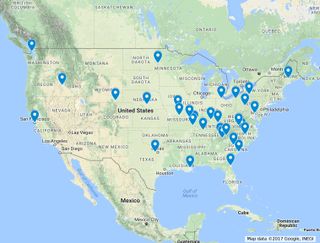Solar Eclipse Fever! Outreach Activities Aim to Spur Celestial Excitement
To help prepare the public for the total solar eclipse on Aug. 21, the American Astronomical Society (AAS) is awarding minigrants to fund outreach activities focused on engaging groups of people who are underrepresented in the science community, such as women, minorities and people with disabilities.
On Thursday (March 16), the AAS Solar Eclipse Task Force announced 31 winners of the minigrants program. Libraries, schools, museums, Boys & Girls Clubs and even a Girl Scout troop are among the recipients. Each project will receive up to $5,000 to spend on eclipse-related activities ranging from classes and workshops to festivals and parties.
This eclipse has been called the Great American Solar Eclipse because the path of totality — where the moon will completely block the sun — crosses the entire contiguous U.S., from Oregon to South Carolina. Viewers who aren't along the path of totality can at least witness a partial solar eclipse. (Either way, you'll need protective eyewear to safely observe the sun.)
"There is clearly a lot of interest in this summer's solar eclipse," Angela Speck, co-chair of the AAS task force and director of astronomy at the University of Missouri, Columbia, said in a statement. "We received 153 mini-grant proposals representing a remarkable amount of creativity and enthusiasm. I wish we could have funded more of them, but the 31 projects we did fund will help spread 'eclipse fever' around the country and will undoubtedly motivate significant numbers of underserved youth to consider careers in science, technology, engineering and math." [Total Solar Eclipse 2017: Path, Viewing Maps and Photo Guide]
One group, at the Great Smoky Mountains National Park in Tennessee, will use its grant to fund a four-day-long solar eclipse science camp for 25 high school students from underserved communities in the area. On the day of the eclipse, the park will host a viewing event for the public during which those students will serve as guides and educators. In New Orleans, a company called F&L Organizational Support Services will run a 10-day-long camp called "EclipseFEST 2017" to get the local youth excited about the eclipse.
Another project, at the University of Missouri, plans to teach hundreds of fifth-grade students how to use sound to study bee behavior during the total solar eclipse. Students at Heyward Gibbes Middle School in Columbia, South Carolina, will take their eclipse activities to a local retirement home, where they will educate the elderly about eclipses, hand out eclipse glasses and watch the solar eclipse.

Another project, on the San Juan Islands in Washington, the Indigenous Education Institute will host events that focus on Native American communities along the path of totality and their cultural history as it pertains to eclipses. The group plans to produce a video "based on native perspectives, cultural knowledge and stories of the sun," according to the project description.
Get the Space.com Newsletter
Breaking space news, the latest updates on rocket launches, skywatching events and more!
The minigrants program was named after the late Julena Steinheider Duncombe, an astronomer from Nebraska who published eclipse predictions and maps for the U.S. Naval Observatory in the 1960s and '70s. Duncombe started the first school-lunch program by preparing meals for students who couldn't afford them.
Funding for the Julena Steinheider Duncombe grants came from the National Science Foundation and are administered by the AAS Solar Eclipse Task Force. You can find a complete list of the grant awardees here.
Email Hanneke Weitering at hweitering@space.com or follow her @hannekescience. Follow us @Spacedotcom, Facebook and Google+. Original article on Space.com.
Join our Space Forums to keep talking space on the latest missions, night sky and more! And if you have a news tip, correction or comment, let us know at: community@space.com.

Hanneke Weitering is a multimedia journalist in the Pacific Northwest reporting on the future of aviation at FutureFlight.aero and Aviation International News and was previously the Editor for Spaceflight and Astronomy news here at Space.com. As an editor with over 10 years of experience in science journalism she has previously written for Scholastic Classroom Magazines, MedPage Today and The Joint Institute for Computational Sciences at Oak Ridge National Laboratory. After studying physics at the University of Tennessee in her hometown of Knoxville, she earned her graduate degree in Science, Health and Environmental Reporting (SHERP) from New York University. Hanneke joined the Space.com team in 2016 as a staff writer and producer, covering topics including spaceflight and astronomy. She currently lives in Seattle, home of the Space Needle, with her cat and two snakes. In her spare time, Hanneke enjoys exploring the Rocky Mountains, basking in nature and looking for dark skies to gaze at the cosmos.
